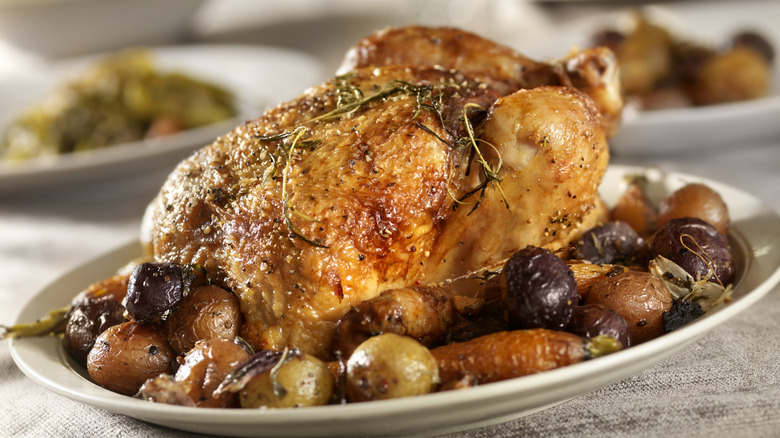The Flipping Technique Jacques Pépin Uses For Perfectly Browned Roast Chicken
Despite all the tips for roasting a whole chicken out there, the task can seem daunting for those attempting it for the first time. After all, it's an entire chicken, which means there's no shortage of meat that requires cooking. Whether you flavor your poultry with citrus à la a lemon-roasted chicken recipe or keep the flavors straightforward with a classic roasted chicken recipe, you'll always want to prioritize an evenly-cooked bird. Luckily, to make the cooking process all the more methodical, celebrity chef Jacques Pépin utilizes a foolproof strategy. He suggests routinely flipping that whole chicken in its pan so each side receives equal, ample time on the heat.
"I like to start it on the side," Pépin explains in a video tutorial for classic roast chicken posted by KQED. "The leg is longer to cook than the front." As such, Pépin gives the legs a head start before he flips his chicken right-side-up. He cooks the first side of the chicken for about 20 minutes at 425 degrees Fahrenheit. From there, he turns the bird and repeats the process on the other leg for the same duration of time. Finally, he cooks the meat when it's flat in the pan for, again, 20 minutes. "At that point, I can baste it," says Pépin. As for the rest of the recipe? With Pépin's technique, roasted chicken comes together seamlessly.
Jacques Pépin's flipping technique ensures an evenly roasted, dinner-ready chicken.
Pépin's process for making roasted chicken is certainly hands-on, perhaps more so than simply popping your poultry in the oven. However, his flipping approach minimizes the dangers of undercooked meat. Chicken should be cooked all the way through and on all sides to circumvent safety issues like salmonella. Yet not only does the flipping approach serve a safety purpose but it also comprises the bulk of the cooking process. Once you embrace Pépin's technique, the rest of the recipe practically finishes itself.
To start, Pépin seasons his chicken with salt and pepper, which he adds to both the bird's inside and exterior skin. He also melts a chunk of butter in the pan. Then, Pépin undergoes those chicken cooking and flipping steps, embracing his roasting process. Once the chicken is on its final flip, Pépin bastes it with the pan's juices. After about an hour or after the accumulation of those three, 20-minute stages, the chicken should be done and ready to rest. Pépin allows the chicken to rest for a few minutes before he begins carving and enjoying the fruits of all that laborious flipping.

